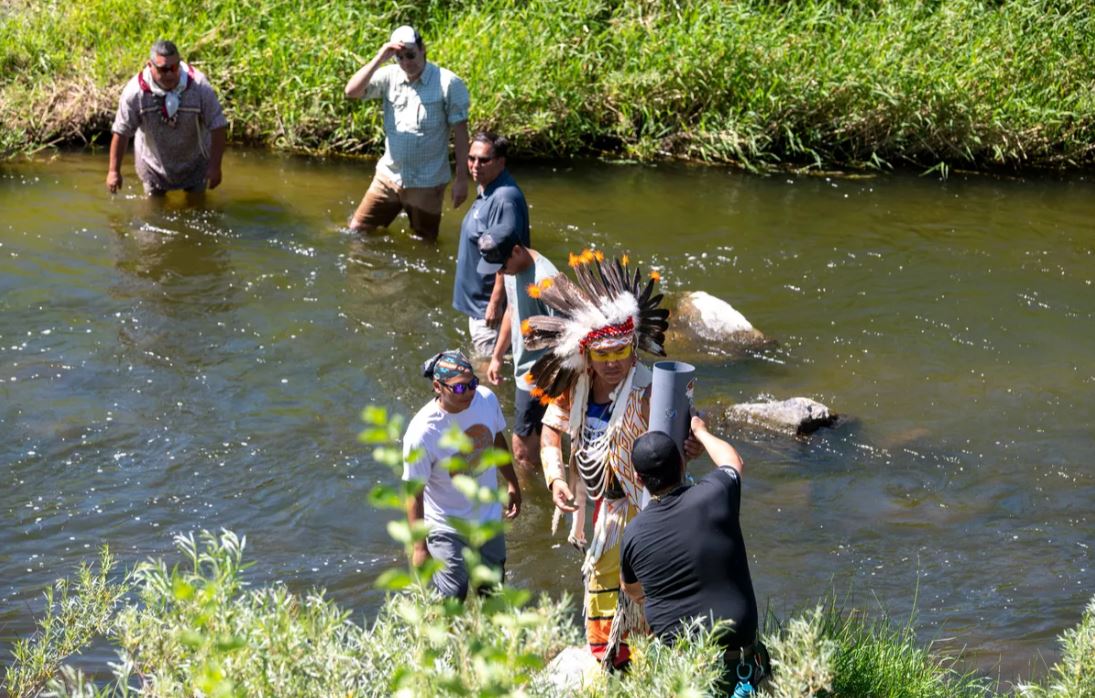From The Spokesman-Review
She was the size of a hot dog when her journey began.
In March 2020, the Coeur d’Alene Tribe released her and more than 1,400 other chinook salmon smolts into upper Hangman Creek near Tensed.
The creek carried her through wheat-covered hills on the Palouse to the Spokane River. From there, she continued north, picking up the Columbia River at Fort Spokane. She swam past apple country, shrub-steppe, forest and Portland before making it to the Pacific Ocean in mid-May, some 700 river miles from where she started.
After two years in the ocean eluding predators and fishermen, she felt an urge to return home. So the 30-inch fish headed back up the Columbia and climbed back over the harrowing dams until she got stuck at the impenetrable wall no salmon can overcome: Chief Joseph Dam near Brewster.
It’d been a valiant effort. She was the only one of the 1,452 smolts to make it so far.
But her journey wasn’t over. She traveled by Dodge pickup from Chief Joseph to Spokane.
And on Tuesday, the Coeur d’Alene Tribe released her back into her home waters. For the first time in 114 years, an adult chinook is swimming in Hangman Creek.
“It means so much,” the tribe’s fish and wildlife program manager Ralph Allan told the dozens of attendees at the release ceremony. “What a great day to be Coeur d’Alene.”
The release served two purposes for the tribe.
First, it had incredible emotional significance. Many whooped, cheered and cried as they watched the green-gray chinook slip below the dark waters and head upstream.
“It’s a symbolic release today to remember our history, our ancestors,” Coeur d’Alene tribe member Vince Peone said.
Salmon are an integral part of life and culture for the Coeur d’Alenes and many Pacific Northwest tribes. Being cut off from the fish means being cut off from part of their identity.
“We, along with this land, cannot be whole until the fish return to these waters,” said Hemene James, a member of the Coeur d’Alene tribal council.
But returning an adult chinook to Hangman Creek is also a key step in the Upper Columbia United Tribes’ broader effort to reintroduce salmon to parts of the Columbia River system currently blocked by dams.
The fact that this chinook made it all the way back to Chief Joseph proves that reintroduction is feasible, Coeur d’Alene Tribe Anadromous Project Lead Tom Biladeau said. Even with degraded habitat and a lack of fish passage systems over dams, the fish can return.
James compared the release to the passing of a baton.
Today’s generation probably won’t see salmon flourishing in the waters blocked by the dams. But their children or grandchildren could. Returning an adult chinook to Hangman Creek is a milestone on the path to full reintroduction, James said.
Allan has been working on salmon reintroduction for 20 years.
He’s been doing the grunt work for much of that time, restoring habitat, readying the waters for when salmon return.
Watching an adult chinook swim in Hangman Creek is evidence that those years of work mattered, Allan said. It’s a tangible sign of progress that will fuel him going forward.
“The salmon took care of us in the beginning of time,” Allan said. “Now it’s our time to take care of the salmon.”

